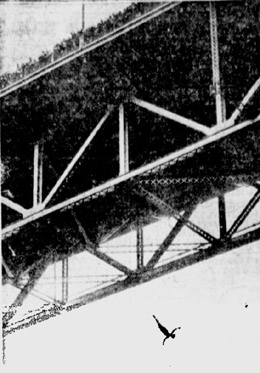On March 17, 1935, daredevil high diver Ray Woods (1908 - 1942) leaps from the George Washington Memorial Bridge (Aurora Bridge) in Seattle and survives. Known for his death-defying leaps in cities across North America, this is his 160th successful dive.
The High Life
Woods, a carnival high diver, began leaping from bridges in 1926 as a way to make money. His first few jumps were near his hometown of St. Louis, and in 1928 he traveled to New York hoping to gain some publicity by jumping off of the Brooklyn Bridge. He performed the stunt three times, but when he only got a few inches of newspaper space, he returned to St. Louis after exclaiming, "New York is only a hick town. The mugs in this burg don’t know if they're alive and most of them don’t know what the whooping is about" (Meriden Record, July 18, 1926).
Unwilling to give up, he began looking for other bridges to leap from. Soon he found that many cities welcomed the daredevil, and that local businesses would pay him to advertise their products after a successful leap. At one point he almost made $20,000 for a leap from Table Rock at Niagara Falls, but a rock fall at the site a week before the event led to a cancellation of his appearance.
When Woods announced his jump from the Aurora Bridge in Seattle, he noted that it would be his highest jump yet. The five-year-old bridge had already gained a sad reputation as a spot for suicide jumpers due to its height of 164 feet. No one had yet survived the fall.
Thousands Watch
On the day of Woods' daredevil stunt, crowds of people started showing up at around 2:00 p.m., and within an hour the Aurora Bridge was filled from side to side, as was the Fremont Bridge below. Thousands more lined the shores of the ship canal, as well as the northern slopes of Queen Anne Hill. In all over 50,000 people were in attendance.
At 3:00, Woods climbed on top of a wooden box placed near the bridge railing directly in the center of the span. The crowd cheered as he stepped over the railing, facing the roadway with his back to the water, the sunlight playing off his red hair and red bathing suit. The cheers went silent as Woods stepped backwards, off into space. He bent at the waist as he plummeted downward, flipping his legs up so as to enter the water arms first.
Woods hit Lake Union hard, his body almost at a 45-degree angle, not perpendicular as he had hoped. The crowd remained silent as he floated there without moving, but when he raised his arms to signal that he was okay, the cheers rang out again. Whistle blasts erupted from all of the nearby pleasure boats.
Pretty Tough
Woods was pulled from the water aboard the cruiser Fellowship, where he was kissed by his wife, Bernice. She asked how he felt, and he replied, "Pretty tough!" After waving once again to the roaring crowd, he turned to address the bridge. "You gave me an awful beating," he said while smiling, "That's the toughest dive I ever made" (Seattle Post-Intelligencer, March 18, 1935).
After the daredevil was taken ashore, he was given a quick rub-down by Washington Athletic Club trainer, Ted Dash. Before the jump, Dash recommended that Woods wear a rubber chest protector. Upon examination, he noticed that the protector had burst open in four places, and probably saved Woods' life.
After the Big Jump
Bruised and battered, Woods spent the next few days in Seattle advertising Ford automobiles for the William O. McKay Company. Afterward he traveled to Vancouver, British Columbia, where he made a successful dive from the Burrard Bridge -- an event that was first banned by the police, but then overruled by Vancouver Mayor Gerry McGeer (1888-1947).
One month after Woods's jump in Seattle, another suicide attempt was made from the Aurora Bridge, but this time the jumper survived. On May 15, a 20-year-old student nurse from Virginia Mason Hospital fell to the water, and suffered only a dislocated hip and a fractured collar bone The Seattle Post-Intelligencer noted that because she jumped from the railing and not the bridge deck, she had beaten Ray Woods's record high dive by three feet.
Woods's bridge-jumping career ended in 1937, when he was blown off balance during a 186-foot leap from the San Francisco-Oakland Bay Bridge. He shattered five vertebrae, paralyzing him from the shoulders down. Although doctors told him he would remain bed-ridden for the rest of his life, Woods eventually began swimming again, and was able to walk with the help of leg braces. He later told the press, "I dived because I loved to travel and that was the only way I knew to see the country and get paid for it. I have no regrets" (Fairport Herald-Mail, "March 16, 1939).
Woods died in 1942 when he fell off a boat during a fishing trip and drowned.

